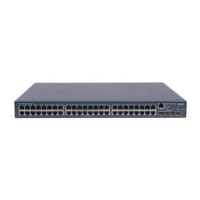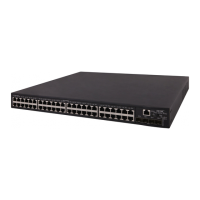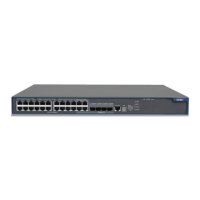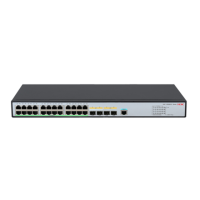1-6
Table 1-4 DLDP packet types and DLDP states
DLDP state Type of DLDP packets sent
Active Advertisement packet with RSY tag
Advertisement Normal Advertisement packet
Probe Probe packet
Disable Disable packet and RecoverProbe packet
When a device transits from a DLDP state other than Inactive state or Disable state to Initial state, it
sends Flush packets.
2) A received DLDP packet is processed as follows.
z In any of the three authentication modes, the packet is dropped if it fails to pass the authentication.
z The packet is dropped if the setting of the interval for sending Advertisement packets it carries
conflicts with the corresponding local setting.
z Other processes.
Table 1-5 Procedures for processing different types of DLDP packets
Packet type Processing procedure
If the corresponding neighbor entry does not exist,
creates the neighbor entry, triggers the Entry timer, and
transits to Probe state.
Advertisement
packet with RSY
tag
Retrieving the
neighbor
information.
If the corresponding neighbor entry already exists, resets
the Entry timer and transits to Probe state.
If the corresponding neighbor entry does not exist,
creates the neighbor entry, triggers the Entry timer, and
transits to Probe state.
Normal
Advertisement
packet
Retrieves the
neighbor
information.
If the corresponding neighbor entry already exists, resets
the Entry timer.
If yes, no process is performed.
Flush packet
Determines
whether or not the
local port is in
Disable state.
If not, removes the corresponding neighbor entry (if any).
If the corresponding neighbor entry does not exist,
creates the neighbor entry, transits to Probe state, and
returns Echo packets.
Probe packet
Retrieves the
neighbor
information.
If the corresponding neighbor entry already exists, resets
the Entry timer and returns Echo packets.

